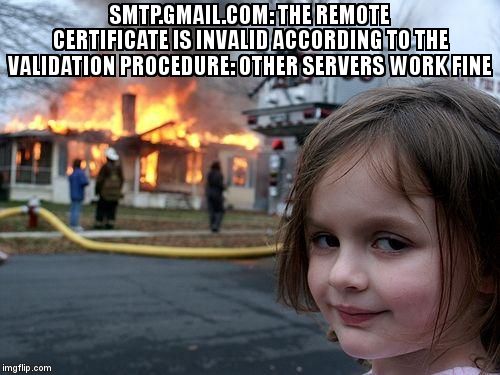


Logger.LogDebug($ " SigninCredentialExtension keyType is ") String keyType = options.GetValue(KeyType) This IIdentityServerBuilder builder, IConfigurationSection options, ILogger logger) Public static IIdentityServerBuilder AddSigninCredentialFromConfig( Private const string KeyStoreIssuer = " KeyStoreIssuer" Private const string KeyFilePassword = " KeyFilePassword" Private const string KeyFilePath = " KeyFilePath" Private const string KeyTypeTemporary = " Temporary" Private const string KeyTypeKeyStore = " KeyStore" Private const string KeyTypeKeyFile = " KeyFile" Private const string KeyType = " KeyType"

THE REMOTE CERTIFICATE IS INVALID ACCORDING TO THE VALIDATION PROCEDURE CODE
( new RequireHttpsAttribute()) Ĭopy Code public static class SigninCredentialExtension this sets up a default authorization policy for the application // in this case, authenticated users are required (besides controllers/actions that have var policy = new AuthorizationPolicyBuilder() SigninCredentialExtension.AddSigninCredentialFromConfig(is4Builder, Configuration.GetSection( " SigninKe圜redentials"), Logger) SqlOptions.MigrationsAssembly(migrationsAssembly))) Add config data (clients, resources, CORS).īuilder.UseSqlite(csConfigurationStore, sqlOptions => var is4Builder = services.AddIdentityServer(options => Services.AddPolicyServerClient(Configuration.GetSection( " Policy"))īuilder.UseSqlite(csApplicationContext, sqlOptions => Var settings = JsonFileManager.Load( + " Config\\svConf.json") Var migrationsAssembly = typeof(Startup).GetTypeInfo().Assembly.GetName().Name String csConfigurationStore = Configuration.GetConnectionString( " ConfigurationStore") string csApplicationContext = Configuration.GetConnectionString( " ApplicationContext") Gets connection strings from "appsettings.json". You can pass verify the path to a CA_BUNDLE file or directory withĬertificates of trusted CAs: > requests.Copy Code public void ConfigureServices(IServiceCollection services)

Or you might give the certificate as trust inside the verify argument. To work around the broken server configuration you might explicitly extract the missing certificates and add them to you trust store. But other browsers or applications will fail too, similar to python. Some desktop browsers work around this configuration problem by trying to load the missing certificates from the internet or fill in with cached certificates. This means that the server configuration is wrong and that not only python but several others will have problems with this site. This server's certificate chain is incomplete. When looking at the analysis by SSLLabs you will note: The problem is not in your code but in the web site you are trying to access. Status: Directory listing of "xxxxxxxxxxxxx" successful Status: Retrieving directory listing of "xxxxxxxxxxxxx". Status: Connection established, waiting for welcome message. Status: Resolving address of xxxxxxxxxxxxxxxxxxxxxx Here's the output from FileZilla: Status: Selected port usually in use by a different protocol. I also tried adding the event client.ValidateCertificate += Client_ValidateCertificate private static void Client_ValidateCertificate(FtpClient control, FtpSslValidationEventArgs e)īut I couldn't get that to work either I still get the same error. Var result = client.UploadFileAsync(FilePathName, RemotePathName, AllowOverwrite ? FtpExists.Overwrite : FtpExists.Skip, CreateRemoteDirectory, token).GetAwaiter().GetResult() Here's my code: var credentials = new NetworkCredential(Username, Password) įtpClient client = new FtpClient(Host, credentials)ĮncryptionMode = FtpEncryptionMode.Explicit Yet FileZilla works fine with no error or warnings.Īm I doing something wrong and if it's actually a problem with the server how can I ignore this error The remote certificate is invalid according to the validation procedure. When I try to connect to my FTP server to upload a file with FluentFTP I get this:


 0 kommentar(er)
0 kommentar(er)
